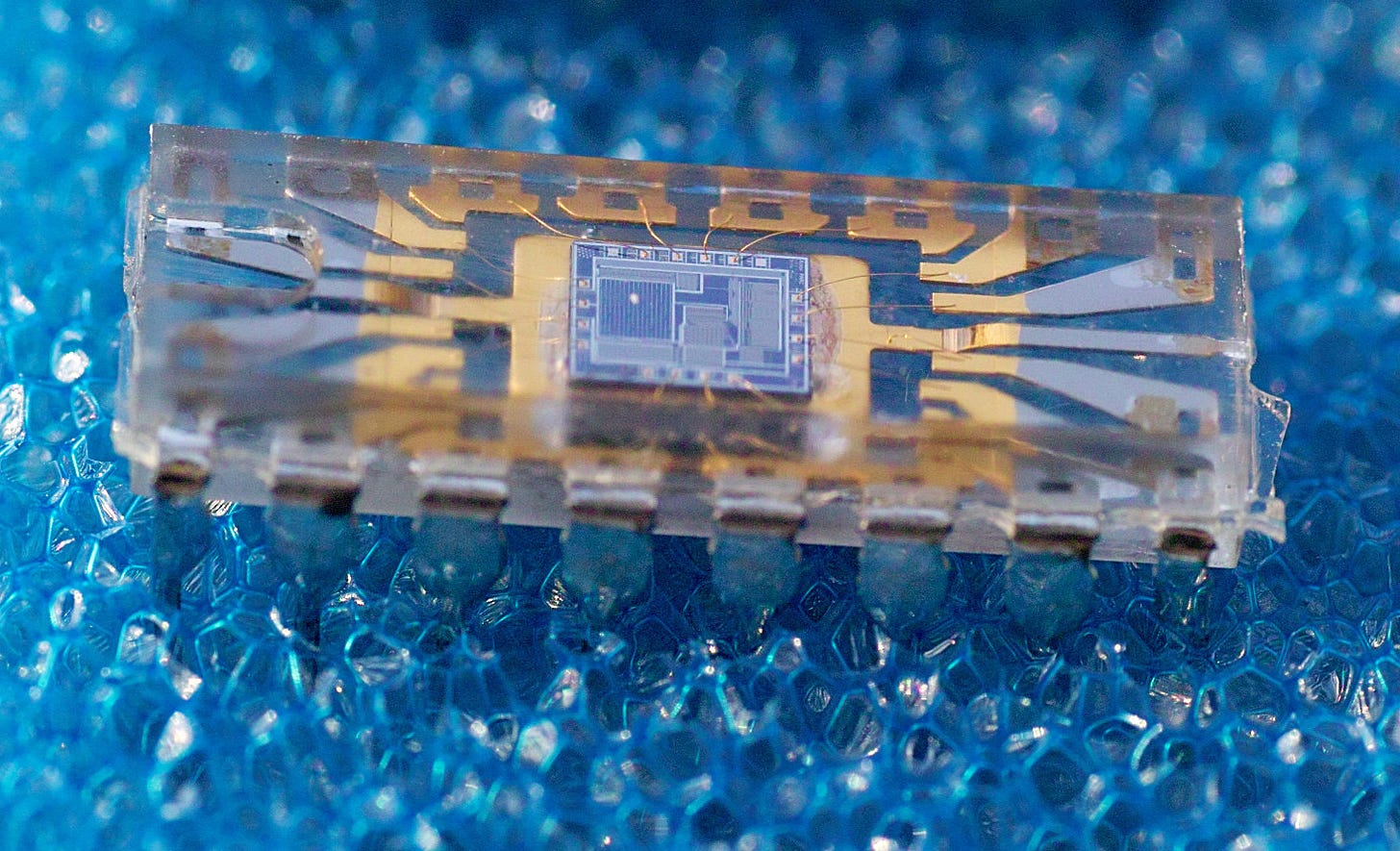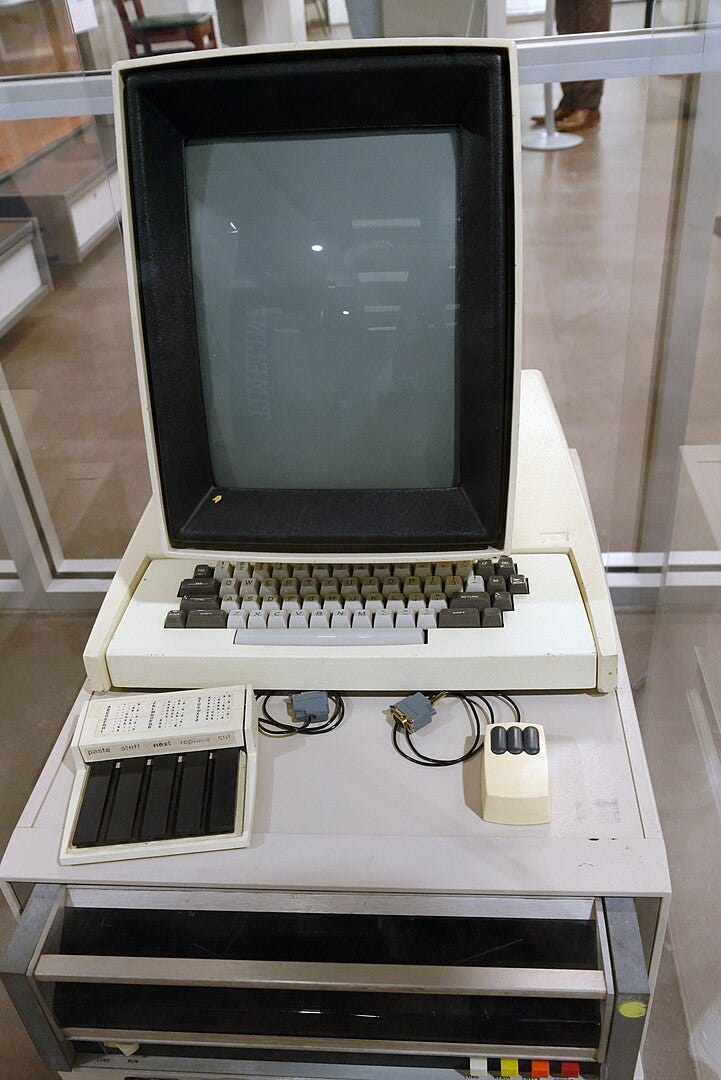Chip Letter Links No. 21 : Xerox PARC Special
Great links, images and reading for 23 July 2023

Hi everyone and thanks for subscribing. This is one of a regular series of posts with links, images and articles of interest, inspired by Adam Tooze’s excellent Chartbook.
Each edition starts with a beautiful die image. This week it’s a chip from a Xerox PARC optical mouse.
If you’re enjoying The Chip Letter then please forward to a friend or colleague.
This edition is a Xerox PARC special, prompted by the launch of the Xerox PARC archive at the Computer History Museum.
Xerox PARC

Xerox PARC (Palo Alto Research Center) was the research and development center for Xerox, founded in 1969 by Xerox’s chief Scientist Jack Goldman.
A short list of technologies developed at Xerox PARC during an amazingly productive few years at the start of the 1970s include:
Ethernet (Bob Metcalfe, 1973-4)
Laser Printers (Gary Starkweather, 1972)
Object Oriented Programming (in the form of Smalltalk, Alan Kay, 1972)
Graphical User Interfaces (in the form of the Xerox Alto, Alan Kay, 1973)
Xerox PARC remains active and in 2023 Xerox announced that it would donate the lab to SRI International, the research laboratory where the first prototype of Douglas Engelbart’s mouse was developed.
Xerox PARC Archive
The Computer History Museum have made available an archive of files and documents from Xerox PARC. It’s a treasure trove of material on the technologies that PARC developed.
To pick just one example, there is PUP (for PARC Universal Packet) which was influential in the design of the TCP/IP internet protocol.
PUP is described in more detail in this PARC paper (on Bitsavers).
The work described in this paper represents one internetwork (sic) architecture, known as Pup, in widespread regular use within Xerox. The name referred originally to the abstract design of a standard internetwork datagram (the PARC Universal Packet), but has expanded in usage to include the whole hierarchy of internetwork protocols as well as a general style for internetwork communication.
There is much more in the archive, including material on programming languages (Mesa, Cedar, Smalltalk, LISP), computers (including the Alto which we will discussed later), graphics and even AI (in its 1970s incarnation).
Steve Jobs on Xerox PARC
Famously, Xerox failed to turn most of the technologies that it developed at PARC into successful commercial products. Instead, others would build huge businesses on the back of these technologies.
Steve Jobs toured PARC and saw object-oriented programming, networking and the Graphical User Interface.
In the 1990s he was interviewed and and recalled his trip concluding that Xerox:
… just grabbed defeat from the greatest victory in the computer industry. Xerox could have owned the entire computer industry today could have been you know a company ten times its size could have been IBM could have been the IBM of the 90s could have been the Microsoft of the 90s.
However, the legend of Jobs and Xerox PARC is a little more nuanced, as Apple engineers already knew about the technology that Jobs saw. The full version of the story is recounted here. Apple and Jobs also refined what they saw at PARC:
Yes, the Macintosh team got an important demo (PARC was compensated with a pre-IPO Apple stock deal). They took up the ideas of the Xerox PARC, but it also changed numerous operating modes and added countless new features.
And Xerox did get some compensation for giving Apple sight of their technology.
Xerox Alto
Jobs saw the Xerox Alto on his visit to PARC. A business computer with a Graphical User Interface and networking.
It’s remarkable to think that the Alto was first introduced in 1973, a decade before the Apple Lisa and the first Macintosh. The Alto was incredibly expensive though, costing the equivalent of around $130,000 in 2023 dollars.
One of the reasons why the Alto was so expensive was that it wasn’t powered by a microprocessor - in 1973 no microprocessor would have been powerful enough to power the Graphical User Interface. Instead it used a custom processor built from TTL components, including 74181 ‘bit slice’ Arithmetic and Logic Unit chips. We can even see the schematics for the Alto’s design here.
Here is an early Xerox advertisement for the Alto.
And Ken Shiriff (of righto blog fame) working on the restoration of an Alto:
Ethernet Birthday
Ethernet celebrated its 50th ‘birthday’ a few weeks ago. Here is Computerphile with a great video explaining how it works.
And inventor Bob Metcalfe, doing an extended briefing on Ethernet in 1978.
And more than 40 years later talking about the emergence of Ethernet from PARC.
And finally, The Computer History Museum hosted a discussion with Ethernet inventor Bob Metcalfe to mark the 50th anniversary of Ethernet.
Dealers of Lightning
The most comprehensive book on Xerox PARC is Dealers of Lightning by Pulitzer Prize winning author Michael Hiltzik. It’s over 20 years old now but still worth browsing. It’s available to borrow at the Internet Archive.
After the break, Xerox Alto and Mac Plus emulators that run in the browser.
The rest of this edition is for paid subscribers. If you value The Chip Letter,then please consider becoming a paid subscriber. You’ll get additional weekly content, learn more and help keep this newsletter going!



